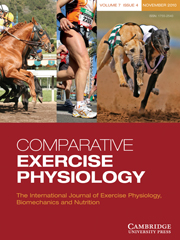Article contents
Effects of vitamin E supplementation and training on oxidative stress parameters measured in exercising horses
Published online by Cambridge University Press: 02 June 2009
Abstract
Exercise places an increased demand on the body's systems, both to provide fuel for working musculature and to neutralize and dispose of toxic build-up. By-products of demanding performance are reactive free radicals. Dietary consumption of vitamin E, an antioxidant, may be a plausible way to reduce free radical damage. The present study examined the effects of supplemental dietary vitamin E on the presence of oxidation products and antioxidant capacity in blood and tissue of exercising horses. Eight Thoroughbred horses were used in a crossover design study, with one group consuming a diet containing vitamin E at the 1989 National Research Council (NRC) level recommended for horses in moderate to intense work (80 IU kg DM− 1 [National Research Council (1989). Nutrient Requirements of Horses. 5th revised edn.; Washingto, DC: National Academy Press, pp. 48]), and the second group being fed the control diet plus 3000 IU day− 1 dl-α-tocopheryl acetate. The horses underwent an adaptation phase, an 8-week training programme and a final standard exercise test (SET) during which the horses ran on a 6° incline to exhaustion, and then a washout phase. Horses were then crossed over to opposite treatment groups and these phases repeated. Blood samples were collected at specific points before and after exercise during the training period and before and after performing the SET. Neither plasma vitamin E nor thiobarbituric acid-reactive substance concentrations were influenced by supplemental vitamin E. Blood Trolox-equivalent antioxidant capacity values increased (P < 0.05) following 5 weeks of training in both groups, indicating improved antioxidant capacity as horses became fitter. Vitamin E supplementation did not alter plasma reduced, oxidized or total glutathione levels, nor the percentage of glutathione in the reduced form during the training period. However, vitamin E did cause an elevation in the percentage of glutathione existing in the reduced form following a SET as compared with the control diet (P < 0.006). This is possibly due to lower plasma oxidized glutathione levels in vitamin E-treated horses (P < 0.03). This study indicates that vitamin E supplementation above NRC levels can influence certain measures of oxidative stress in intensely exercising horses, and training has the ability to improve the antioxidant status of the animal.
Information
- Type
- Research Paper
- Information
- Copyright
- Copyright © Cambridge University Press 2009
Footnotes
Present address: Edgar Rhodes Ctr. For ADS, University of Georgia, 425 River Road, Athens, GA 30 602, USA
References
- 6
- Cited by

